This is a story about the railway stations in Bač, Novi Sad, Sremski Karlovci, Petrovaradin and Belgrade, about how Serbia could have looked if we had not allowed the total devastation of the railway infrastructure and how it is connected to the huge General Motors corruption scandal in the USA 60 years ago.
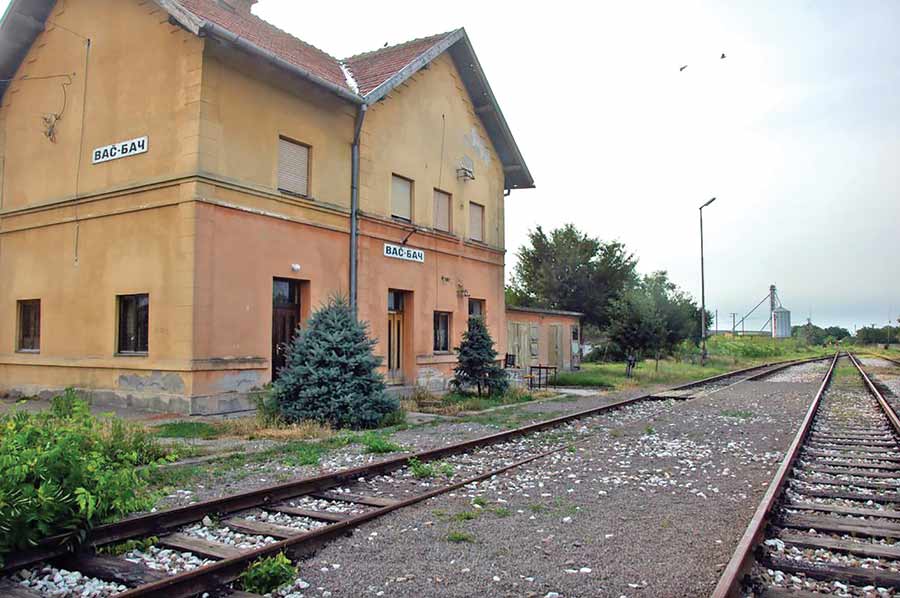
Bač, the place where I was born, used to have its own railway, as well as the railway station built by the Austro-Hungarian Empire. A friend of mine from elementary school, Saša Milenković, whose father was a train dispatcher, lived in that yellow building with the identical, subsequently “cleaned” façade plaster just like all other stations in the Habsburg Monarchy at the end of the 19th and the beginning of the 20th century – from Lvov to South Tyrol. Our relatives from Sombor came to visit us along that railway, in a small train. Then at the beginning of the 1990s, about the same time that the cinema in Bač was closed, the railway was also closed and a padlock was put on the railway station.

Senior citizens of Novi Sad have told me that, in the capital of Vojvodina, there was the sentiment similar to the one in today’s Belgrade, when in 1961, the railway station from the Grbavica town quarter was relocated next to the bus station and was connected to the rest of the town by the wide Bulevar Oslobodjenja. Since the construction of the railway in 1883, the train entered Novi Sad through the tunnel dug under the Petrovaradin Fortress. The tunnel is in excellent condition today – I have gone inside recently – but it is completely unused. However, it might serve, for example, as an excellent new exhibition space for the upcoming 2021 European Capital of Culture events.
After passing through the tunnel, the train would get directly to the Joseph Frank Bridge and the passengers used to describe the wonderful sight, when after the dark of the tunnel, they saw the light and Novi Sad with the towers of its seven churches on the right. In 1944, the bridge was destroyed for the last time by the German troops withdrawing from the town. People say that the last people to go through Novi Sad, before the arrival of the Partisans, were the allies of the occupying army – the Circassian riders on their black horses.
The railroad then turned right after the tunnel and went over the Varadin Bridge (destroyed on 1st April 1999) into the territory of Bačka. During those 17 years, the railroad passed through the Strossmayer Street in Podgradje – the old part of Petrovaradin. The wheels of the trains on this railroad were at the same height as the windows on the first floor of the 18th century baroque buildings, which must have been a special experience for the people living there.
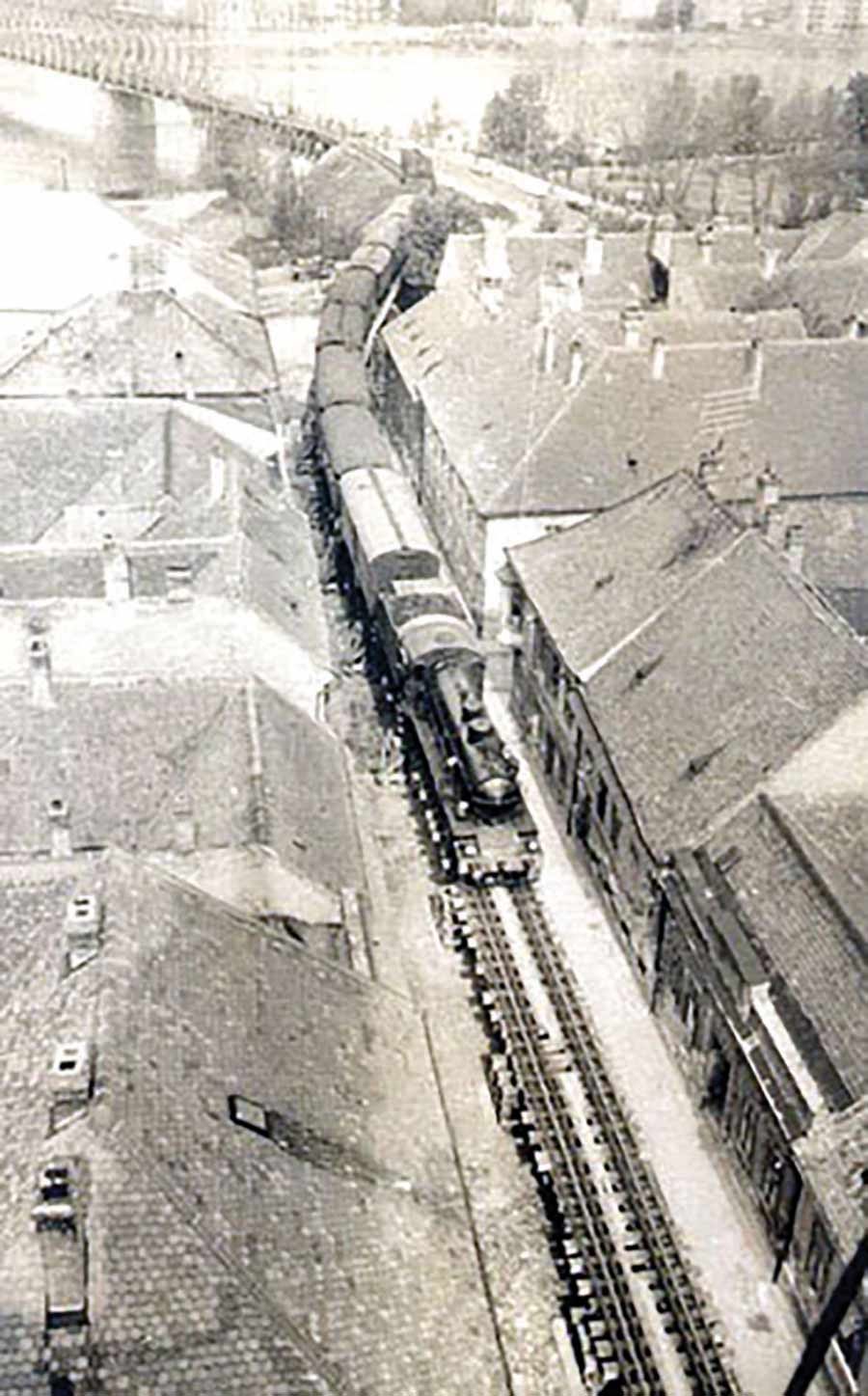
TUCINDAN TRAGEDY AND MODERN-DAY FARSE
Engineer Predrag Djuranović wrote the following for the KCNS’s website: “Hundreds of people and dozens of trains passed through the Novi Sad station every day, and the station’s environment was tailored to the needs of an everyday man. It was alive day and night, on weekdays, weekends, and especially on holidays. This is where people had their New Year Eve’s parties. , The Novi Sad railway station was the hub of the famous historical event, the Tucindan Tragedy. Namely, on Tucidan, 4th January, 1890, Jaša Tomić killed Miša Dimitrijević at a crowded train station. In the period between the two wars, there was a notable expansion of railway traffic at the Novi Sad station with 60 trains departing the station daily, and the same number arriving. 17 trains a day used to leave for Subotica, 22 for Belgrade, 6 for Bečej, 4 for Titel, 8 for Sombor, 2 for Palanka and 2 for Parage, which made a daily total of 200.”
From 1961 to the present day, not counting a couple of months of railway traffic interruption due to the destroyed Žeželj Bridge, the railroad entered the city the same place, and only the oldest citizens of Novi Sad remember the old railway station which was located in the place of today’s Liman Post Office. From this station, the passengers were driven by trams and horse-drawn carriages to the city. However, everybody still vividly remembers a farcical attempt to relocate the Bus Station in Novi Sad from a decade ago that completely failed, namely the already constructed new bus station building was abandoned, and a number of lawsuits between the City of Novi Sad and the developer of the new station ensued.
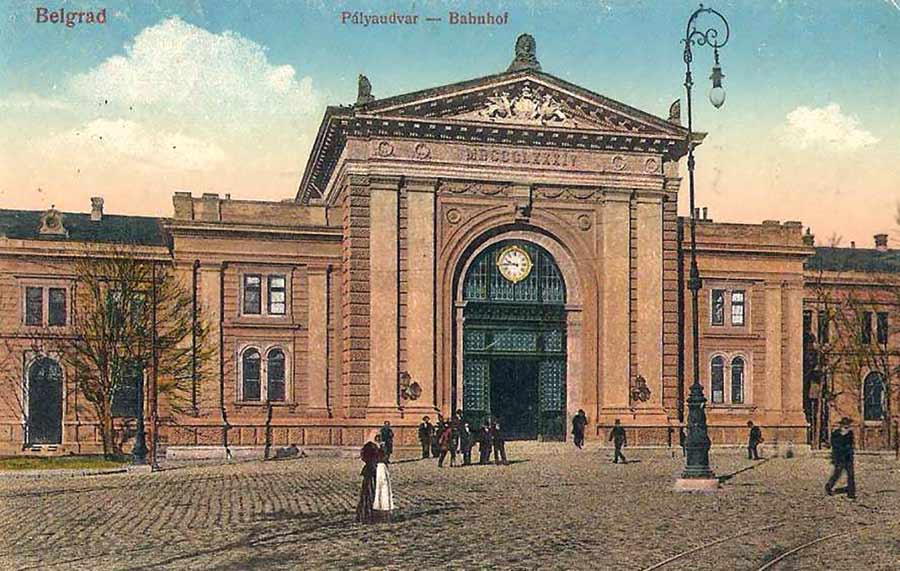
My first memory of the Central Railway Station in Belgrade was from the early 1990s when, as a young journalist, I came from Novi Sad and from that station, trying to dodge smugglers and street tricksters, I walked up to Terazije, or picked up the tram to the BIGZ building, where the offices of Duga magazine were located at that time. Then, over time, buses became faster than the trains, so our journey to Belgrade was usually by a bus, and later by a car.

SILVER-PLATED HACK AND BLUE TRAIN
After a long time, I came to the Central Railway Station in Belgrade on 16th March this year, when we held a promotion of Hello! Travel: Vojvodina tourism magazine on Tito’s Blue Train. Our guests gathered in the newly opened restaurant Station 1884, located in the very heart of the station, and, from the platform 1, boarded the Blue Train to go to Sremski Karlovci. The Vojvodinian Prime Minister, Igor Mirović, the ambassadors of the USA, Israel, Norway, Croatia, Montenegro, Slovenia, Indonesia and Albania, the deputy ambassadors of Russia, France and Germany, twenty other diplomats, media representatives and public figures were all on the train. For this occasion, we staged an exhibition of paintings titled “Tito on the Blue Train and the Galeb Ship” on the train, which showcased to our foreign guests, both younger and older, all the guests that joined the President of the Socialist Federal Republic of Yugoslavia on the aforementioned train and the ship which included the King Haile Selassie I, Sophia Loren and Queen Elizabeth II.
Only two weeks earlier, I had “inspected” the Blue Train to make sure that it was in a good condition. However, I could not presume what was the state of the Serbian railways. The event that we were about to organize in the Blue Train, with 30 or so ambassadors and the Vojvodinian PM in attendance, on a railroad which reputation left a lot to be desired, was not routine by any stretch of imagination even for us, considering the fact that we put together at least 50 different events each year. I used to stick my head into the darkness of Srem every now and then to check how far along we were. Our “inspection” of the building that housed the Sremski Karlovci railway station a couple of days earlier has lead to the decision for the train to stop a few meters before the actual station so that our guests would have to cross the railroad on foot to avoid seeing the interior of the station’s building which resembled the perfect location for Eli Roth’s film “Hostel 4”.
Exactly 137 years after King Milan Obrenović I used a silver-plated hack to officially mark the beginning of the construction of the Belgrade-Niš railroad on 3rd July, 1881 (the railroad was eventually opened for traffic in 1884), the same railroad is in a catastrophically bad condition. The scandal relating to the accusations that General Motors had been bribing mayors and governors all over the country from the mid-1930s to the 1950s, while “encouraging” them to take out tram rails and calling them “obsolete technology “, in order for GM to sell more cars and buses, shook the US for a long time. As a result, many US cities, that were accustomed to the European way of life (trams, pedestrian zones, parks), became alienated places where people did everything in their cars – go to work, east fast food at McDrive, buy fuel and get home.
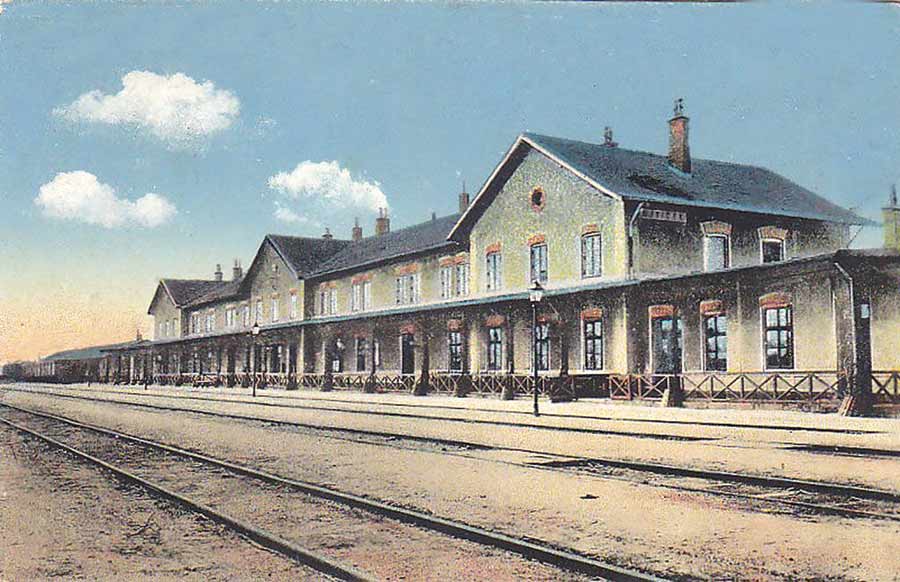
DREAMING ABOUT HIGH-SPEED RAIL
Maybe, one day, we will find out who has been bribing the politicians in Serbia for the past 30 years to have allowed such devastation of the railway infrastructure – railroads, station buildings, marshalling stations and other facilities. Or are we talking about endemic negligence here? Imagine Serbia with good railways! A person from Požarevac going to work to Belgrade every day by train… An enjoyable 30-minute drive in one direction, enough to read the newspapers or check e-mails. This person lives in Požarevac, in their family home, in a town where the living costs are low and works in a capital where the salaries are high and job selection even higher. People from all over Serbia would be arriving in one of the large industrial or administrative centres in half an hour (Belgrade, Nis, Novi Sad, Kragujevac) by train. The smaller towns would not resemble ghost ones and high school students would not dream so much about moving to Novi Sad or Belgrade, as the first step in the process of leaving their own country for good.
On 1st July, we received the news that the Central Railway Station in Belgrade would close. A couple of days earlier, my colleague Zlatko and I took the last train from Novi Sad to this station. Some ten days earlier, accompanied by a song “Now, Let’s Bid Goodbye” (“A sad adio”), the last train leaving for Bar left the Central Railway Station in Belgrade. The trains for Montenegro now depart from the Topčider Station, which looks like a small village station somewhere deep in Hungary, with a waiting room that has no benches and chairs.
We decided to celebrate our last departure by train for Novi Sad by having lunch at the Station 1884 restaurant. The four of us sat alone, in a completely empty restaurant with the contemporary interior and excellent cuisine. Then somebody said: “Your train leaves in one minute. Zlatko and I paid our lunch and I literally flew into the train on the platform number 3, which headed to Novi Sad only a couple of seconds later, at exactly at three o’clock in the afternoon.
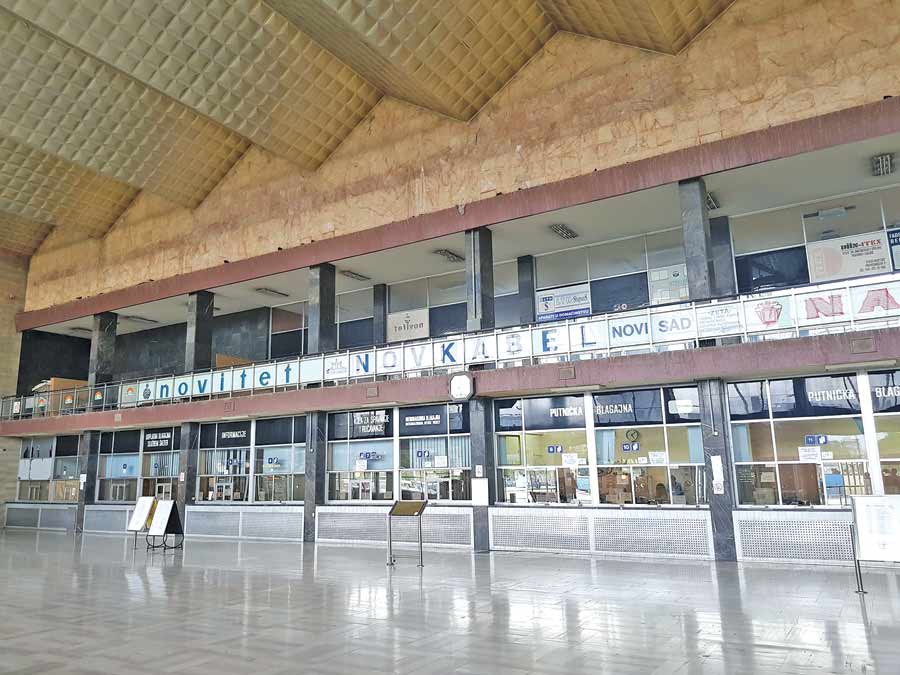
COUNTRY IS FALLING APART, BUT PEOPLE ARE STILL HOLDING ON
We sat in the first class that has only 12 seats. Apart from the two of us, there were three workers of the former Railways of Serbia (Železnice Srbije), a national railway company that has been split into several companies. We see the platforms, covered in grass, passing us by, and workers taking the benches apart. After 134 years, this train station is counting its last days.
“Do you see this building? We’ll have to tear it down at our expense! We are giving away the land worth billions of euros for free, and we still have to pay for the building to be torn down”, says one of the fellow travelers, pointing towards one of the smaller facilities that will be destroyed in order to make room for the Belgrade Waterfront project. “Railroads have been systematically destroyed in this country for years. The Prijepolje railway station is used by the local private bus companies which uses one of the station’s counter to sell their tickets. The departure of the train running between Šabac and Ruma was scheduled exactly every three hours so that the workers from local factories would not make it and for a private bus company, owned by a local politician, to get all the passengers”, the fellow traveler continues. A man selling peanuts and other bits and bobs gets off the train at the Zemun Polje station. “This man has been selling his stuff on this train for almost 30 years, and we are powerless to throw him out.” The display announces the next station, albeit written only in the Cyrillic writing. Five people from Slovenia, who are sitting in the next train car while their bicycles are stored away (yes, there is a place for bicycles on the train), will maybe be able to decipher the word “Indjija” in the Cyrillic writing, but I seriously doubt that other foreigners would be able to do so.
The train stops and then goes into a different direction. “We are now going to Golubinci, where we will wait for ten minutes or so, because the railroad is being repaired”, other fellow traveler informs us. Station after station – Indjija, Beška, Čortanovci, Karlovački Vinogradi, Sremski Karlovci, Petrovaradin – are passing before our eyes, and we are finally entering Novi Sad via “the new Žeželj Bridge”. We are right on time, exactly two hours after we departed Belgrade.
All railway stations on the Belgrade – Novi Sad stretch look neglected, with muddy facades and graffiti written all over them. In contrast, the girl who works as a train dispatcher at the Beška station, dressed in a perfectly tailored uniform, has greeted us with the kindness that you see on trains in Austria or Switzerland. We had a similar impression of the young, charming conductor woman who checked our tickets. The country is falling apart, but the people are still holding on.
We get off the train at the Novi Sad station. Through the window on the platform, we see an exhibition of photographs of railway stations in Vojvodina, while it is virtually impossible to enter the room that should house the Railway Museum from the station’s platform. The adjacent room, which looks like “a first-class waiting room” with leather armchairs enveloped in thick dust and a bizarre model of a train from, I would guess Austria, is also locked.
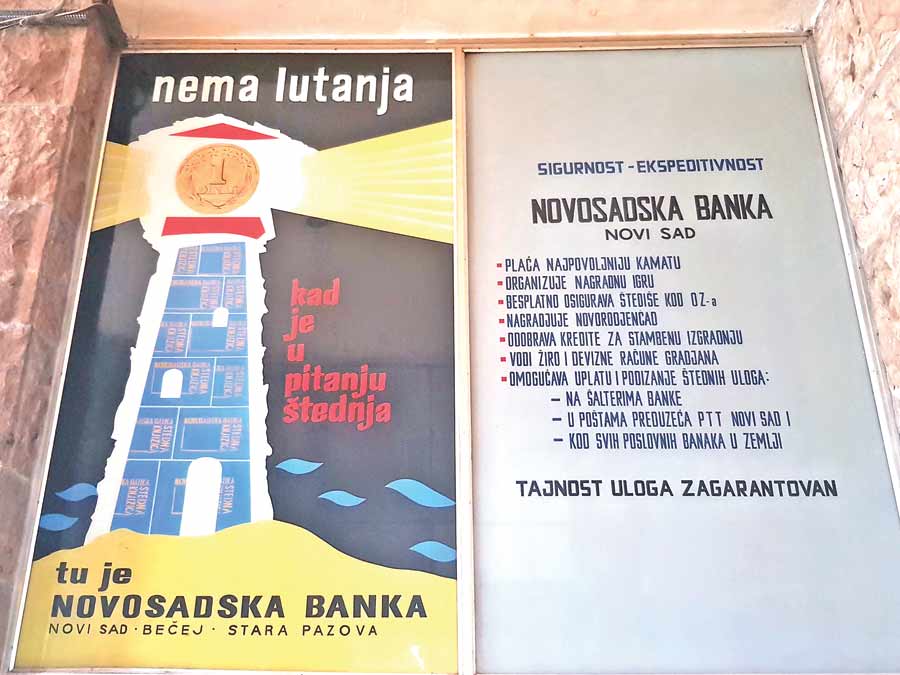
At the entrance to the station’s restaurant, which looks exactly as it did in the early 1990s when we went there as students after a night out in the nearby Area night club, there is an old-fashioned advertisement for a brand that no longer exists – “Novosadska Bank” (which changed the name to Erste Bank after it was acquired by the eponymous bank). The advertisement of the non-existent bank and its slogan “No Wandering” promises a lot – among other things, there is a promise of a prize game and gifts for newborn babies. On the ground floor, at the hair salon called Mira, which, it seems, has not changed since the Socialist era of the 1970s, the salon owner, Mira is cutting the hair of an elderly gentleman.
WHEN PIGEONS GO SILENT
In the spacious station hall, which construction was completed in 1964 and which was designed by architects Imre Farkaš and Milan Matović, I counted more pigeons than people at the counters. At night, they say, people outnumber pigeons. Homeless people come to sleep here because it is dry. Pigeons nest in the hall, feathers and everything else that the pigeons leave behind can be seen at every step. There is something very creepy about an abandoned kiosk which bears the faded Coca-Cola advertisement and a sticker with Šešelj’s image. A dead pigeon lies in it.
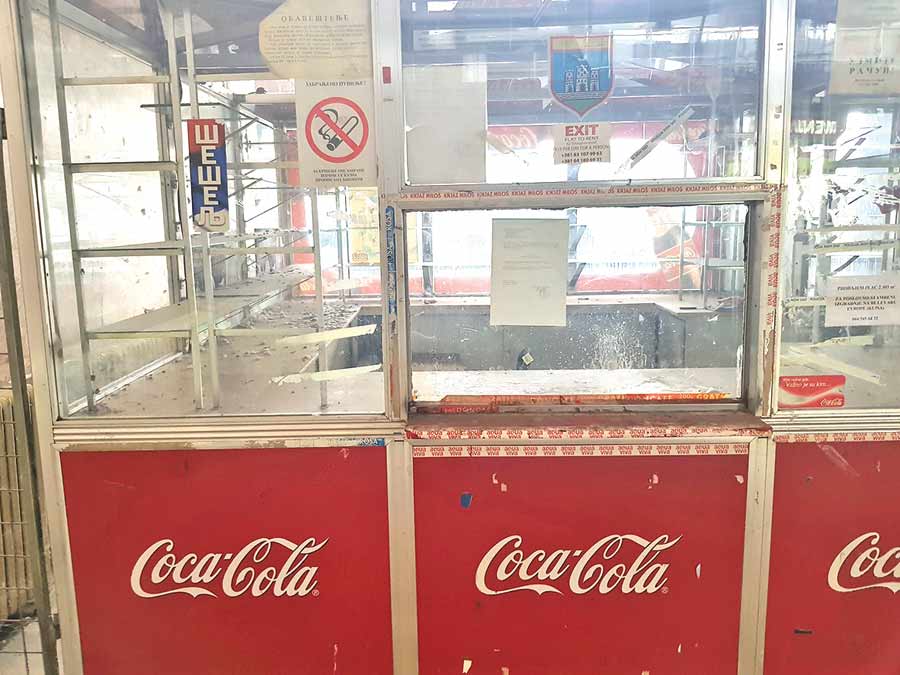
While searching online for the information about the Novi Sad railway station on the 021.rs website, I found the following comment:”This station made me sick to my stomach a few years ago. I waited for my cousin there who was supposed to arrive on the last train from Belgrade, around midnight. I came into the station’s building, and the floor was full of blood, as if I stepped in an abattoir. I got momentarily scared because I thought that a killer psychopath was running around, stabbing people. And then, in the corner of my eye, I saw a guy, dressed as a railway worker, shooting pigeons all over the station with a pellet gun. When shot, they fall down on the floor, broken bones and all, flapping their wings while blood is splattered everywhere. It was a horrific sight! Now, I can see that they have installed anti-bird spikes all over the station. But the scene with the railway worker shooting pigeons with his pellet gun will never leave my mind!” This comment was left by a man who signed himself as Evgenije.

Let’s go back to the central railway station in Belgrade, known worldwide for being featured in the famous films such as “From Russia with Love” and “The Orient Express”. If we are to believe the authorities, one day this building will house a museum and in front of it, there will be a monument erected in honour of the founder of the Nemanjić dynasty. “Beograd, Belgrad, Belgrade!” These words that echoed in Bond’s ears in the above mentioned film, will be heard in some other places from now on.

Rođen 27.7.1968. u Baču (Vojvodina, Srbija). Srednju školu završio u Bačkoj Palanci, Pravni fakultet studirao u Novom Sadu. Od 1990. radi kao novinar – u početku kao novosadski dopisnik beogradskih “Večernjih novosti”; zagrebačke “Arene”, sarajevskih “Naših dana”. Sarađuje i u magazinima “Vreme” i “Stav”.
1992. sa grupom studenata obnavlja izlaženje studentskog mesečnika “Index”. Posle dva broja sledi smena celokupne redakcije i pokretanje magazina “Nezavisi Index” koji će kasnije 1993. promeniti ime u “Svet” iz kojeg je nastala izdavačka kuća Color Press Grupa.
Danas na čelu Color Press Grupe najvećeg izdavača magazina u regionu sa kompanijama u svih 6 republika – 110 magazina, 25 internet portala i preko 80 konferencija i festivala godišnje.
U porfoliju kompanije pored domaćih (poput magazina “Lepota i zdravlje”, “Svet”, “Pošalji recept”, “Lekovito bilje” itd) nalaze se i brojni licencni brendovi: “The Economist”, “Hello!”, “Gloria”, “Story”, “Star”, “Lisa Moj stan”, “Hausbau”, “Brava Casa”, “Bravo”, “Alan Ford”, “Grazia”, “La Cucina Italiana”, “Auto Bild” i brojni drugi.
